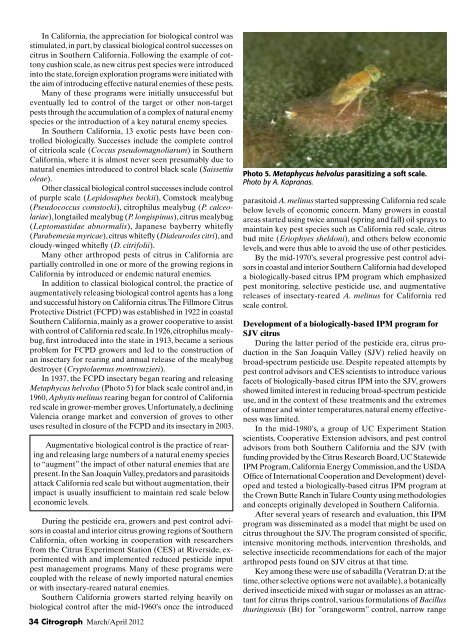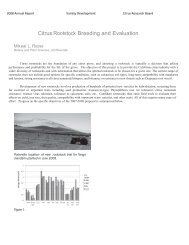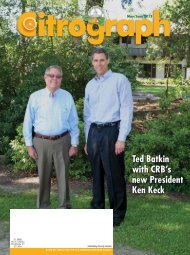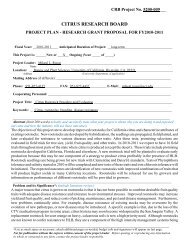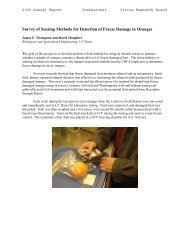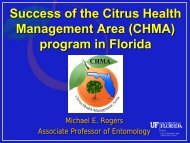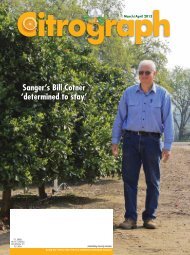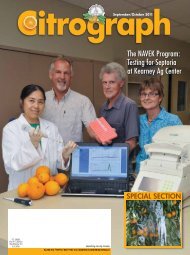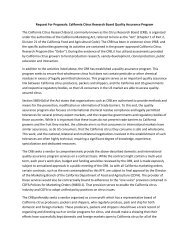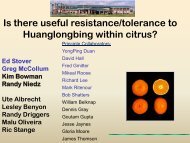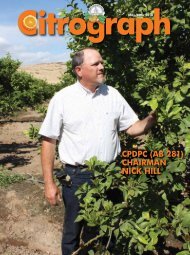IPM practitioner Joe Barcinas with IPM researcher Joseph Morse
IPM practitioner Joe Barcinas with IPM researcher Joseph Morse
IPM practitioner Joe Barcinas with IPM researcher Joseph Morse
You also want an ePaper? Increase the reach of your titles
YUMPU automatically turns print PDFs into web optimized ePapers that Google loves.
In California, the appreciation for biological control was<br />
stimulated, in part, by classical biological control successes on<br />
citrus in Southern California. Following the example of cottony<br />
cushion scale, as new citrus pest species were introduced<br />
into the state, foreign exploration programs were initiated <strong>with</strong><br />
the aim of introducing effective natural enemies of these pests.<br />
Many of these programs were initially unsuccessful but<br />
eventually led to control of the target or other non-target<br />
pests through the accumulation of a complex of natural enemy<br />
species or the introduction of a key natural enemy species.<br />
In Southern California, 13 exotic pests have been controlled<br />
biologically. Successes include the complete control<br />
of citricola scale (Coccus pseudomagnoliarum) in Southern<br />
California, where it is almost never seen presumably due to<br />
natural enemies introduced to control black scale (Saissettia<br />
oleae).<br />
Other classical biological control successes include control<br />
of purple scale (Lepidosaphes beckii), Comstock mealybug<br />
(Pseudococcus comstocki), citrophilus mealybug (P. calceolariae),<br />
longtailed mealybug (P. longispinus), citrus mealybug<br />
(Leptomastidae abnormalis), Japanese bayberry whitefly<br />
(Parabemesia myricae), citrus whitefly (Dialeurodes citri), and<br />
cloudy-winged whitefly (D. citrifolii).<br />
Many other arthropod pests of citrus in California are<br />
partially controlled in one or more of the growing regions in<br />
California by introduced or endemic natural enemies.<br />
In addition to classical biological control, the practice of<br />
augmentatively releasing biological control agents has a long<br />
and successful history on California citrus. The Fillmore Citrus<br />
Protective District (FCPD) was established in 1922 in coastal<br />
Southern California, mainly as a grower cooperative to assist<br />
<strong>with</strong> control of California red scale. In 1926, citrophilus mealybug,<br />
first introduced into the state in 1913, became a serious<br />
problem for FCPD growers and led to the construction of<br />
an insectary for rearing and annual release of the mealybug<br />
destroyer (Cryptolaemus montrouzieri).<br />
In 1937, the FCPD insectary began rearing and releasing<br />
Metaphycus helvolus (Photo 5) for black scale control and, in<br />
1960, Aphytis melinus rearing began for control of California<br />
red scale in grower-member groves. Unfortunately, a declining<br />
Valencia orange market and conversion of groves to other<br />
uses resulted in closure of the FCPD and its insectary in 2003.<br />
Augmentative biological control is the practice of rearing<br />
and releasing large numbers of a natural enemy species<br />
to “augment” the impact of other natural enemies that are<br />
present. In the San Joaquin Valley, predators and parasitoids<br />
attack California red scale but <strong>with</strong>out augmentation, their<br />
impact is usually insufficient to maintain red scale below<br />
economic levels.<br />
During the pesticide era, growers and pest control advisors<br />
in coastal and interior citrus growing regions of Southern<br />
California, often working in cooperation <strong>with</strong> <strong>researcher</strong>s<br />
from the Citrus Experiment Station (CES) at Riverside, experimented<br />
<strong>with</strong> and implemented reduced pesticide input<br />
pest management programs. Many of these programs were<br />
coupled <strong>with</strong> the release of newly imported natural enemies<br />
or <strong>with</strong> insectary-reared natural enemies.<br />
Southern California growers started relying heavily on<br />
biological control after the mid-1960’s once the introduced<br />
34 Citrograph March/April 2012<br />
Photo 5. Metaphycus helvolus parasitizing a soft scale.<br />
Photo by A. Kapranas.<br />
parasitoid A. melinus started suppressing California red scale<br />
below levels of economic concern. Many growers in coastal<br />
areas started using twice annual (spring and fall) oil sprays to<br />
maintain key pest species such as California red scale, citrus<br />
bud mite (Eriophyes sheldoni), and others below economic<br />
levels, and were thus able to avoid the use of other pesticides.<br />
By the mid-1970’s, several progressive pest control advisors<br />
in coastal and interior Southern California had developed<br />
a biologically-based citrus <strong>IPM</strong> program which emphasized<br />
pest monitoring, selective pesticide use, and augmentative<br />
releases of insectary-reared A. melinus for California red<br />
scale control.<br />
Development of a biologically-based <strong>IPM</strong> program for<br />
SJV citrus<br />
During the latter period of the pesticide era, citrus production<br />
in the San Joaquin Valley (SJV) relied heavily on<br />
broad-spectrum pesticide use. Despite repeated attempts by<br />
pest control advisors and CES scientists to introduce various<br />
facets of biologically-based citrus <strong>IPM</strong> into the SJV, growers<br />
showed limited interest in reducing broad-spectrum pesticide<br />
use, and in the context of these treatments and the extremes<br />
of summer and winter temperatures, natural enemy effectiveness<br />
was limited.<br />
In the mid-1980’s, a group of UC Experiment Station<br />
scientists, Cooperative Extension advisors, and pest control<br />
advisors from both Southern California and the SJV (<strong>with</strong><br />
funding provided by the Citrus Research Board, UC Statewide<br />
<strong>IPM</strong> Program, California Energy Commission, and the USDA<br />
Office of International Cooperation and Development) developed<br />
and tested a biologically-based citrus <strong>IPM</strong> program at<br />
the Crown Butte Ranch in Tulare County using methodologies<br />
and concepts originally developed in Southern California.<br />
After several years of research and evaluation, this <strong>IPM</strong><br />
program was disseminated as a model that might be used on<br />
citrus throughout the SJV. The program consisted of specific,<br />
intensive monitoring methods, intervention thresholds, and<br />
selective insecticide recommendations for each of the major<br />
arthropod pests found on SJV citrus at that time.<br />
Key among these were use of sabadilla (Veratran D; at the<br />
time, other selective options were not available), a botanically<br />
derived insecticide mixed <strong>with</strong> sugar or molasses as an attractant<br />
for citrus thrips control, various formulations of Bacillus<br />
thuringiensis (Bt) for ”orangeworm” control, narrow range


